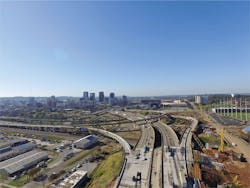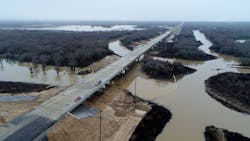Region Report: Deep South
LOUISIANA:
Protection keeps system exposed
by Bill Wilson, Editorial Director
Nobody wants to put someone to work lining up hospital beds beside a dumpster.
Taking care of the health of any community should always be put in the forefront, even if roads and bridges are left wrapped in bandages. Transportation funding in Louisiana has been at a poor level for years, and complicating matters is a state budget that is protected. Health care is one of three areas that could be cut (public safety and higher education are the other two), but it might as well be bottled in bullet-proof glass.
“It doesn’t make sense to have great roads if it leads to businesses and hospitals and universities that are closed,” Louisiana Transportation Secretary Shawn Wilson told Roads & Bridges.
So the Louisiana Department of Transportation and Development (LaDOTD) is left with the state gas tax, which stands at 16 cents per gallon and has not been raised since the early days of President George H.W. Bush’s administration.
“[The state gas tax] has lost 50% of its value,” said Wilson.
As a result, LaDOTD has $13.9 billion in unmet needs, and the agency has been forced into preservation-only mode—while the bridge network suffers. Wilson had to close over 50 bridges in 2017, and since Jan. 1 five more have been taken out of service. Complicating matters are a number of timber bridges in the state, which are responsible for moving goods to market, including whatever the fracking industry produces. That means heavy trucks are crossing vulnerable bridges.
Road conditions are mixed in Louisiana. Wilson said the interstate system is in pretty good shape, but the grade of urban pavement varies. Since 2011, 54% of funds have been spent on rural roads compared to city roads, and the ones constructed in heavily populated areas usually carry a much bigger price tag.
The passage of the FAST Act did help some. LaDOTD has received an extra $730-750 million annually in federal funding. Most of the money has been pushed over to freight corridor improvements. Grants and bonds also have helped, but they have created more of a scratch-and-claw mentality. The LaDOTD will take anything it can get its hands on these days. The Fast Lane Grant provided an extra $60 million, which has been injected into rehabbing and widening pavement on I-10 between Lafayette and Breaux Bridge. However, it is merely a dent—the total cost for the three-phased 15-mile-long project is $183 million. Phases 1 and 2 are under construction now, and Phase 3 will begin in 2019. Interstate 10 is Louisiana’s premier freight route, and when the job is finished less than 1% of the pavement on I-10 will be rated poor or very poor.
“That is one of the last segments that is the original pavement when the interstate was built,” said Wilson.
Gov. John Bel Edwards recently announced a $650 million GARVEE bond package, which will be used on the following projects:
- A new interchange at Barksdale Air Force Base on I-20/I-220;
- Reconstructing a flyover and interchange at Loyola. The interchange is currently at a D service level;
- Widening a bridge on I-10 in Baton Rouge; and
- The Bell Chase Bridge and Tunnel Replacement project, which will be a public-private partnership (P3).
When asked if he thought P3s could play an instrumental role in getting the road and bridge network back on track in Louisiana, Wilson seemed on the fence: “I don’t see it as a way to dig us out of our infrastructure hole. Our challenge is how do you provide a return on investment on any P3? The only way we can do that is with tolls. We have some structures and key footprint projects I think are going to have to be tolled.”
----------------
The I-20/59 project will replace a 1.5-mile stretch of interstate to improve access to Birmingham. Images: Alabama DOT
ALABAMA:
Trying something new
By Tim Bruns, Associate Editor
Like many DOTs around the country, the Alabama Department of Transportation (ALDOT) is eagerly anticipating the arrival of a new federal infrastructure package out of Washington.
The recent unveiling of an infrastructure proposal from the White House comes at a time when ALDOT is gearing up to begin work on the state’s first public-private partnership (P3) project: the Mobile River Bridge and Bayway. Plans would create a new passageway for I-10 over the Mobile River and the Port of Mobile. Currently, a set of twin-span tunnels bring I-10 traffic under the river. “Those tunnels have become one of the biggest chokepoints for congestion on I-10 coast to coast,” ALDOT spokesman Tony Harris told Roads & Bridges. “So it’s incredibly important for us to find a solution to that chokepoint, which has gone now from seasonal to almost year-round.”
Widening will be required at the interchanges along I-10. The bridge will follow the existing I-10 route to the northeast and shift east to cross over the Canal Street interchange, span the Mobile Harbor Federal Navigation Channel, and tie into the I-10 Bayway. The pricetag is expected to be in the range of $1.5 to $2 billion. Of course, details are still being worked out, and the anticipated federal infrastructure package will determine how funding comes together.
ALDOT currently maintains 5,745 bridges in the state, spending about $80 million per year on bridge replacements for approximately 40 bridges annually. Of the department’s total state bridge inventory, only about 90 of those bridges are considered structurally deficient, down significantly from the 213 structurally deficient bridges in 2007. According to a May 2017 TRIP report, about 11% of Alabama’s major roads are in poor or mediocre condition, and 25% of urban interstates in the state experience congestion during peak hours.
Under the FAST Act, ALDOT brought in around $776 million in federal funding for transportation projects in FY16. Combined with the approximately $495 million coming from state funds, the department sees an average annual budget of about $1.27 billion.
Aside from the anticipated Mobile River P3 project, Alabama’s largest city, Birmingham, is currently undergoing major roadwork with the I-20/59 project through the heart of the city’s central business district. The four-phase $750 million project is designed to improve interstate access into downtown. The final phase will replace the entire 1.5-mile stretch of elevated interstate.
“It was installed in the early 1970s with a traffic count of about 80,000 cars a day,” Harris said. “Actual traffic counts now have more than doubled.” Both bridge structures of I-20/59 run east-west and are structurally deficient. The whole project is scheduled for completion by late 2019.
Two of the last five winters in Alabama have seen above average levels of snow and ice in the state. Over the last few years, ALDOT has been investing funds in the construction of salt brine stations for winter maintenance operations in the northern third of the state—and also expanding salt brine use in the central part as a result of an icier winter this year. “We had snow in early December and again in early January,” Harris said. “That’s the first time I can recall in my lifetime two snow events in one year.”
----------------
The new U.S. 51 Coldwater River Bridge is a 2,000-ft structure designed to prevent flooding, which the area suffers on a regular basis; it’ll open this spring. Image: Mississippi DOT
MISSISSIPPI:
More than the numbers
By Brian W. Budzynski, Managing Editor
Going strictly by the numbers, Mississippi isn’t doing so well.
Two out of every three miles of the state’s major urban roads are in at best “mediocre” condition, with 43% in flat out “poor” shape, according to a 2017 report by TRIP. The state holds 17,068 bridges, 12% of which are considered structurally deficient; the FHWA’s new classification rating finds nearly 1,500 state bridges to be “poor.” Forty-three percent of urban roads and highways are in dire condition, and the state ranks fifth in the nation for deficient rural pavements with 25% in bad shape. And the rural road fatality rate statewide is the fourth highest in the nation at 2.93 deaths per 100 million miles traveled. The Texas Transportation Institute estimates that $350 million per year is wasted in Mississippi in lost time and wasted fuel.
There are multiple causes of this level of degradation, but the biggie is, as it tends to be everywhere, a dearth of dollars.
“The current level of funding means the state-owned rural highway system will continue to be neglected,” Mississippi Department of Transportation (MDOT) Executive Director Melinda McGrath said in a recent statement.
So, by the numbers, Mississippi is in pretty bad straits. But numbers don’t tell the entire story. Across the state, there are pockets of growth and improvement that are swelling.
Near Ocean Spring, I-10 is being widened from four lanes to six, with six bridges along the way being rehabbed. Overhead intelligent traffic sign trusses are being installed and the corridor will be traffic-ready by this spring. And further along I-10, in Jackson County, a bridge over the East Pascagoula River is being rescued. This bridge preservation project will stabilize two settled bents on the bridge by raising the bridge superstructure to its original position and recasting the connection to the substructure. There also will be monitoring equipment installed that will alert MDOT if the bents move in the future. The estimated cost of replacing the bridge would have exceeded $500 million; however, this preservation is estimated to cost just over $579,000 and will restore the bridge’s original lifespan of 75 years.
One of the most significant projects in the state is the $150 million U.S. Highway 49 Infrastructure Improvement Project in Rankin County. According to MDOT, the project is on target for 2020, with new lanes being added that will save taxpayers the cost of building and removing a temporary travel lane, and once the project is complete also will decrease congestion along this heavily traveled route south of Jackson, the state capital and largest city.
In Oktibbeha County, the first phase of a safety project on S.R. 12 was recently completed. Crews removed an existing center, two-way left-turn lane and replaced it with a raised concrete curb median. The new raised medians prevent potential conflict points of turning traffic. Traffic signals also were upgraded with fiber connections to allow for better communication and control from a central location. Traffic cameras were installed to allow real-time monitoring. A second phase of the project is expected to be complete in fall 2018.
Finally, up in Tate County, the U.S. Highway 51 Coldwater River Bridge Replacement (pictured) is 95% done. Work remains to add a lift of asphalt to the bridge approaches, install guardrails and stripe the lanes. The bridge, which replaces a structure half its size, is on schedule to open this spring.



